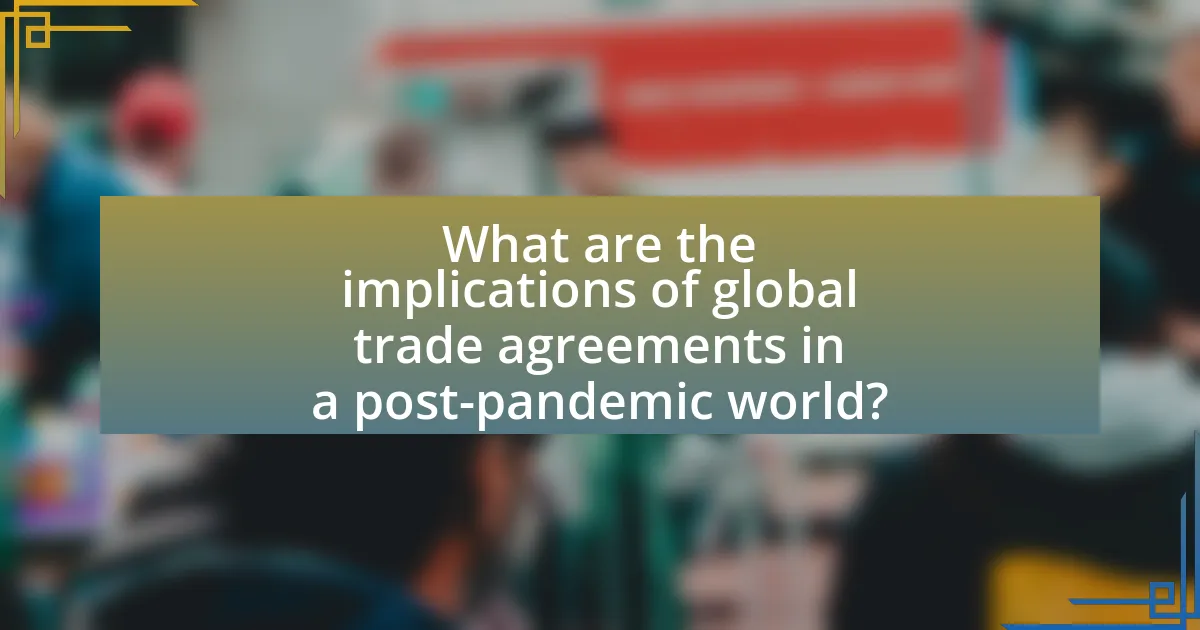The article focuses on the future of global trade agreements in a post-pandemic world, highlighting the implications of recent shifts in trade dynamics. It examines how the COVID-19 pandemic has reshaped global trade by accelerating digital trade, altering supply chain structures, and prompting countries to prioritize resilience and sustainability in trade agreements. Key challenges such as rising protectionism, geopolitical tensions, and the need for adaptation to technological advancements are discussed, along with the potential benefits of new trade agreements for developing countries. The article also explores emerging trends, best practices, and strategies for enhancing the effectiveness of future trade agreements, emphasizing the importance of inclusivity and transparency in negotiations.

What are the implications of global trade agreements in a post-pandemic world?
Global trade agreements in a post-pandemic world are likely to emphasize resilience, sustainability, and digital trade. The COVID-19 pandemic exposed vulnerabilities in global supply chains, prompting nations to prioritize agreements that enhance supply chain resilience and reduce dependency on single sources. For instance, the World Trade Organization reported a significant shift towards regional trade agreements as countries seek to secure essential goods and services. Additionally, there is an increasing focus on environmental standards within trade agreements, reflecting a global commitment to sustainability, as seen in the European Union’s Green Deal influencing trade policies. Furthermore, the rise of digital trade, accelerated by the pandemic, is leading to the inclusion of provisions for e-commerce and data flow in trade agreements, as highlighted by the Comprehensive and Progressive Agreement for Trans-Pacific Partnership. These implications indicate a transformative approach to global trade, prioritizing stability, environmental responsibility, and technological advancement.
How has the COVID-19 pandemic reshaped global trade dynamics?
The COVID-19 pandemic has significantly reshaped global trade dynamics by accelerating the shift towards digital trade and altering supply chain structures. As countries implemented lockdowns and restrictions, businesses faced disruptions that highlighted vulnerabilities in traditional supply chains, leading to a reevaluation of sourcing strategies. For instance, global merchandise trade volume fell by 5.3% in 2020, according to the World Trade Organization, prompting companies to diversify suppliers and invest in technology to enhance resilience. Additionally, the pandemic spurred an increase in e-commerce, with global online sales growing by 27.6% in 2020, as consumers shifted to digital platforms for purchasing goods. This transformation indicates a long-term trend towards more integrated digital trade frameworks and a potential reconfiguration of trade agreements to accommodate these changes.
What specific challenges did the pandemic pose to existing trade agreements?
The pandemic posed significant challenges to existing trade agreements by disrupting supply chains, leading to delays and increased costs. For instance, lockdowns and restrictions on movement hindered the transportation of goods, causing shortages and affecting trade flows. Additionally, the pandemic prompted countries to prioritize domestic production and implement export restrictions on essential goods, undermining the principles of free trade embedded in many agreements. According to the World Trade Organization, global merchandise trade volume fell by 5.3% in 2020, illustrating the extent of the disruption. These factors collectively strained the effectiveness and relevance of existing trade agreements in a rapidly changing global landscape.
How did countries respond to trade disruptions during the pandemic?
Countries responded to trade disruptions during the pandemic by implementing various measures to stabilize their economies and ensure the flow of essential goods. For instance, many nations imposed export restrictions on critical medical supplies and food products to safeguard domestic needs, as seen in countries like India and Vietnam. Additionally, governments increased support for local industries through financial aid and subsidies, which helped mitigate the impact of supply chain interruptions. According to the World Trade Organization, global merchandise trade volume fell by 5.3% in 2020, prompting countries to seek alternative trade partnerships and diversify supply sources to enhance resilience against future disruptions.
What role do global trade agreements play in economic recovery?
Global trade agreements play a crucial role in economic recovery by facilitating trade, reducing tariffs, and promoting investment among countries. These agreements enable nations to access larger markets, which can lead to increased exports and job creation. For instance, the Comprehensive and Progressive Agreement for Trans-Pacific Partnership (CPTPP) has been shown to boost trade among member countries by an estimated 1.9% of GDP by 2030, according to the Asia-Pacific Economic Cooperation (APEC). Additionally, trade agreements often include provisions that enhance cooperation in areas such as technology transfer and regulatory alignment, further supporting economic resilience and growth in the aftermath of economic disruptions like the COVID-19 pandemic.
How can trade agreements facilitate economic resilience post-pandemic?
Trade agreements can facilitate economic resilience post-pandemic by enhancing market access, reducing tariffs, and promoting cooperation among nations. These agreements enable countries to diversify their supply chains, which mitigates risks associated with future disruptions, as evidenced by the World Trade Organization’s findings that trade liberalization can lead to increased economic stability. Furthermore, trade agreements often include provisions for regulatory cooperation and standards alignment, which can streamline processes and reduce costs for businesses, thereby fostering a more robust economic environment. For instance, the Regional Comprehensive Economic Partnership (RCEP) aims to strengthen economic ties among member countries, demonstrating how such agreements can bolster collective recovery efforts in the aftermath of the pandemic.
What are the potential benefits of new trade agreements for developing countries?
New trade agreements can significantly benefit developing countries by enhancing market access, promoting economic growth, and attracting foreign investment. These agreements often reduce tariffs and trade barriers, allowing developing nations to export their goods more competitively. For instance, the African Continental Free Trade Area (AfCFTA) aims to create a single market for goods and services across Africa, potentially increasing intra-African trade by 52.3% by 2022, according to the African Union. Additionally, trade agreements can lead to technology transfer and capacity building, as foreign companies often bring advanced technologies and practices to local markets. This can improve productivity and innovation in developing economies, fostering sustainable development.

How are countries re-evaluating their trade strategies?
Countries are re-evaluating their trade strategies by shifting focus towards regional trade agreements and diversifying supply chains. This shift is largely driven by the disruptions caused by the COVID-19 pandemic, which exposed vulnerabilities in global supply chains and reliance on single markets. For instance, nations are increasingly forming trade partnerships within their regions, as seen in the rise of agreements like the Regional Comprehensive Economic Partnership (RCEP) in Asia, which aims to enhance economic cooperation among member countries. Additionally, countries are investing in technology and digital trade to streamline processes and reduce dependency on traditional trade routes, reflecting a broader trend towards resilience and adaptability in trade policies.
What factors are influencing countries to renegotiate trade agreements?
Countries are influenced to renegotiate trade agreements primarily due to economic shifts, changing political landscapes, and evolving global supply chains. Economic shifts, such as the impact of the COVID-19 pandemic, have led to increased protectionism and a focus on domestic industries, prompting nations to reassess their trade commitments. Political changes, including the rise of populism and nationalism, have also driven countries to seek more favorable terms that align with their domestic agendas. Additionally, disruptions in global supply chains have highlighted vulnerabilities, encouraging nations to prioritize resilience and self-sufficiency in their trade policies. For instance, the U.S. has renegotiated agreements to address trade imbalances and protect key industries, reflecting these broader trends.
How do geopolitical tensions affect trade negotiations?
Geopolitical tensions significantly disrupt trade negotiations by creating uncertainty and mistrust among nations. When countries experience conflicts or strained relations, they often impose tariffs, sanctions, or trade barriers, which complicate negotiations and can lead to stalled agreements. For instance, the trade war between the United States and China resulted in increased tariffs on hundreds of billions of dollars’ worth of goods, demonstrating how geopolitical issues can directly impact trade dynamics. Additionally, geopolitical tensions can shift alliances and influence the priorities of nations, further complicating the negotiation landscape.
What role does public health play in shaping trade policies?
Public health significantly influences the formulation of trade policies by prioritizing health standards and regulations that protect populations. For instance, during the COVID-19 pandemic, countries implemented trade restrictions on goods that posed health risks, such as food safety regulations and the export of medical supplies. These actions demonstrate how public health concerns can lead to the establishment of trade barriers aimed at safeguarding public health, thereby shaping international trade agreements. Additionally, the World Health Organization’s guidelines on health and trade emphasize the need for countries to align their trade policies with public health objectives, reinforcing the interconnectedness of these domains.
What are the emerging trends in global trade agreements?
Emerging trends in global trade agreements include a shift towards regionalism, increased focus on digital trade, and the incorporation of sustainability measures. Regional trade agreements are gaining prominence as countries seek to strengthen economic ties within specific geographic areas, exemplified by agreements like the Regional Comprehensive Economic Partnership (RCEP), which includes 15 Asia-Pacific nations and represents about 30% of the global economy. Additionally, the rise of e-commerce has prompted nations to prioritize digital trade provisions in agreements, as seen in the United States-Mexico-Canada Agreement (USMCA), which includes chapters on digital trade. Furthermore, there is a growing emphasis on sustainability, with trade agreements increasingly addressing environmental standards and labor rights, reflecting global priorities for climate action and social responsibility. These trends indicate a significant evolution in how countries approach trade in a post-pandemic context, adapting to new economic realities and societal expectations.
How is digital trade being integrated into new agreements?
Digital trade is being integrated into new agreements through the inclusion of provisions that facilitate cross-border data flows, enhance e-commerce regulations, and establish frameworks for digital services. For instance, the United States-Mexico-Canada Agreement (USMCA) incorporates specific chapters dedicated to digital trade, which promote the free flow of data and prohibit data localization requirements. Additionally, the Comprehensive and Progressive Agreement for Trans-Pacific Partnership (CPTPP) includes commitments to ensure that digital trade barriers are minimized, thereby fostering a more interconnected global economy. These integrations reflect a growing recognition of the importance of digital commerce in driving economic growth and innovation in the post-pandemic world.
What environmental considerations are becoming part of trade discussions?
Environmental considerations increasingly integrated into trade discussions include climate change mitigation, sustainable resource management, and biodiversity protection. These factors are becoming essential as countries recognize the need for trade policies that align with environmental sustainability goals. For instance, the European Union’s Green Deal emphasizes reducing carbon emissions and promoting circular economies within trade agreements. Additionally, the inclusion of environmental standards in trade agreements, such as the US-Mexico-Canada Agreement (USMCA), reflects a growing trend to ensure that trade practices do not compromise ecological integrity.

What challenges do global trade agreements face in the future?
Global trade agreements face significant challenges in the future, including rising protectionism, geopolitical tensions, and the need for adaptation to digital trade. Protectionism has increased as countries prioritize domestic industries, evidenced by the U.S.-China trade war, which led to tariffs and trade barriers that disrupt global supply chains. Geopolitical tensions, particularly between major economies, complicate negotiations and can lead to fragmented trade blocs, as seen in the European Union’s challenges with Brexit. Additionally, the rapid evolution of digital trade requires agreements to address issues like data privacy and cybersecurity, which current frameworks often overlook. These factors collectively threaten the effectiveness and relevance of global trade agreements moving forward.
How do protectionist policies impact international trade agreements?
Protectionist policies significantly hinder international trade agreements by creating barriers to trade, such as tariffs and quotas. These barriers reduce the willingness of countries to engage in trade negotiations, as they often lead to retaliatory measures that escalate into trade wars. For instance, the U.S.-China trade war, initiated in 2018, saw both nations imposing tariffs on billions of dollars’ worth of goods, which disrupted existing trade agreements and complicated future negotiations. Additionally, protectionist measures can lead to decreased market access for exporters, ultimately resulting in reduced economic growth and increased prices for consumers. Historical data shows that countries adopting protectionist policies often experience a decline in trade volume, as seen during the Great Depression when high tariffs led to a significant drop in international trade.
What are the risks of trade wars in a post-pandemic context?
The risks of trade wars in a post-pandemic context include economic instability, supply chain disruptions, and increased consumer prices. Economic instability arises as countries impose tariffs, leading to retaliatory measures that can slow down global trade growth; for instance, the World Bank projected a decline in global GDP growth by 1.5% due to trade tensions. Supply chain disruptions occur as companies face higher costs and delays, which were already exacerbated by the pandemic; a McKinsey report indicated that 93% of companies experienced supply chain disruptions during COVID-19. Increased consumer prices result from tariffs being passed on to consumers, which can lead to inflation; the U.S. Trade Representative noted that tariffs on Chinese goods raised prices for American consumers by approximately $1,300 per year on average.
How can countries balance national interests with global cooperation?
Countries can balance national interests with global cooperation by engaging in multilateral negotiations that prioritize mutual benefits while safeguarding domestic priorities. For instance, trade agreements like the Comprehensive and Progressive Agreement for Trans-Pacific Partnership (CPTPP) illustrate how countries can create frameworks that enhance trade while allowing for individual member states to maintain certain protections for their industries. This approach fosters collaboration on global issues such as climate change and public health, as seen during the COVID-19 pandemic, where countries recognized the need for coordinated responses to shared challenges. By establishing clear communication channels and setting common goals, nations can align their national interests with the broader objectives of global cooperation, ensuring that both are addressed effectively.
What are the implications of technological advancements on trade agreements?
Technological advancements significantly impact trade agreements by facilitating more efficient processes and enabling new forms of trade. For instance, the rise of digital trade and e-commerce has led to the inclusion of provisions addressing data flows and cybersecurity in agreements like the United States-Mexico-Canada Agreement (USMCA). Additionally, technologies such as blockchain enhance transparency and traceability in supply chains, which can lead to more robust compliance mechanisms in trade agreements. The World Trade Organization (WTO) has noted that digital technologies can reduce trade costs by up to 30%, underscoring their transformative potential in shaping modern trade frameworks.
How is automation changing the landscape of global trade?
Automation is transforming global trade by enhancing efficiency, reducing costs, and enabling faster transactions. The integration of technologies such as artificial intelligence, robotics, and blockchain streamlines supply chain processes, minimizes human error, and accelerates the movement of goods across borders. For instance, a McKinsey report indicates that automation could increase productivity in logistics by up to 30%, significantly impacting trade dynamics. Additionally, automated customs processes can reduce clearance times, facilitating quicker access to markets. As a result, countries that adopt automation in trade are likely to gain competitive advantages, reshaping the global trade landscape.
What role does cybersecurity play in trade agreements?
Cybersecurity plays a critical role in trade agreements by ensuring the protection of sensitive data and maintaining trust between trading partners. As global trade increasingly relies on digital platforms, the risk of cyber threats has escalated, prompting countries to incorporate cybersecurity measures into their agreements. For instance, the United States-Mexico-Canada Agreement (USMCA) includes provisions aimed at enhancing cybersecurity cooperation, reflecting the necessity of safeguarding intellectual property and personal data. This integration of cybersecurity into trade agreements not only mitigates risks but also fosters a secure environment for economic collaboration, thereby enhancing overall trade stability and growth.
What best practices can countries adopt for future trade agreements?
Countries can adopt several best practices for future trade agreements, including prioritizing transparency, incorporating sustainability measures, and ensuring inclusivity. Transparency in negotiations fosters trust and allows stakeholders to understand the implications of agreements, as evidenced by the World Trade Organization’s emphasis on open communication. Incorporating sustainability measures addresses environmental concerns and aligns with global climate goals, supported by the Paris Agreement’s framework. Ensuring inclusivity allows for the participation of diverse stakeholders, which can enhance the legitimacy and effectiveness of trade agreements, as highlighted by the United Nations Conference on Trade and Development’s recommendations for equitable trade practices.
How can countries ensure inclusivity in trade negotiations?
Countries can ensure inclusivity in trade negotiations by actively involving diverse stakeholders, including marginalized communities, small and medium enterprises, and civil society organizations. This approach allows for a broader range of perspectives and interests to be represented, which can lead to more equitable outcomes. For instance, the World Trade Organization emphasizes the importance of stakeholder engagement in its guidelines, highlighting that inclusive processes can enhance legitimacy and public support for trade agreements. Additionally, countries can implement mechanisms such as public consultations and advisory committees to gather input from various groups, ensuring that the voices of those affected by trade policies are heard and considered.
What strategies can enhance the effectiveness of trade agreements?
To enhance the effectiveness of trade agreements, countries should prioritize transparency, stakeholder engagement, and adaptive frameworks. Transparency fosters trust among parties, as seen in the Comprehensive and Progressive Agreement for Trans-Pacific Partnership, which emphasizes clear communication of terms. Stakeholder engagement ensures that the interests of businesses and communities are considered, leading to broader support and compliance, as demonstrated by the European Union’s approach to public consultations in trade negotiations. Adaptive frameworks allow agreements to evolve with changing economic conditions, which is crucial in a post-pandemic world where supply chains are increasingly dynamic. These strategies collectively contribute to more robust and resilient trade agreements.















